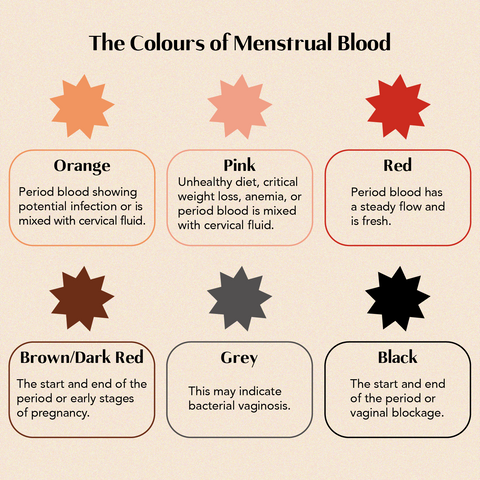Why is my period blood brown?
February 4 2020 | Written by Miranda Van Haarlem (She/Her), Graphics by Sissi Chen (She/Her)
Like many of us menstruators, I remember my first period like it was yesterday. I was 10-years old, it was a Friday, and the night of my town’s MuchMusic Video Dance. It was the classic example of going to the bathroom and discovering something different in your underwear. I was confused… it was brown. I showed my mom my underwear and, because I was so young, she thought it was just a stomach flu. We both look back on this story now and laugh. While this is a slightly embarrassing story to tell, I don’t think I was the only one to discover that period blood isn’t always cherry red.
In past blog posts we have discussed the lack of realistic menstrual blood in media. With menstrual product companies using blue dye to depict menstrual blood, how the heck am I supposed to know what colour period blood is supposed to be?
In reality, menstrual blood can be a variety of colours ranging from shades of red to brown to even black. In this blog post, we are going to discuss the range of period blood colours and what they can mean and hopefully you won’t be as surprised as me!
Bright Red Menstrual Blood
This is what I was expecting when I first got my period. Many individuals start out with bright red menstrual blood; it signifies that the blood is fresh and has a steady flow. Your menstrual blood may stay this colour throughout your whole menstrual cycle, but may darken as your flow begins to slow down.
Dark Red Menstrual Blood
Dark red menstrual blood is typically seen towards the end of your period or you may see this colour waking up in the morning. Why is this? The longer period blood remains in the uterus the higher the chance it will react with oxygen and become oxidized. Blood that has had time to oxidize will appear darker than blood that has a steady flow.
Brown Menstrual Blood
Brown menstrual blood is associated with the beginning or the end of your period. We just went over why you may see darker menstrual blood towards the end of your period, but why do we see it at the beginning if we have a steady flow? Brown blood at the beginning is usually leftover period blood from your last cycle, therefore it is older blood and has become oxidized.
Black Menstrual Blood
If your menstrual blood has ever been black you know how alarming this can be, but it isn’t necessarily a reason to be concerned. Black blood, just like brown blood, is older blood that has been oxidized within the uterus. It is just truly taking its time to leave.
When black blood becomes the norm it can signify a blockage within the vagina and it is recommended you visit your local practitioner if you have any concerns or other symptoms.
Pink Menstrual Blood
Pink menstrual blood is usually associated with spotting towards the beginning and end of your period. The pink colour is usually a sign that your menstrual blood has mixed with cervical fluid. Some menstruators experience light red, and pink spotting within the middle of their cycle and this is known as ovulation bleeding.
Orange Menstrual Blood
Orange menstrual blood can also signify that your menstrual blood has mixed with your cervical fluid but it can also be a symptom of an infection.such as bacterial vaginosis, which is an overgrowth of bacteria found in the vagina. If you have noticed orange menstrual blood and have symptoms such as itching, foul-smelling vaginal discharge and/or a fever, it is recommended you visit your local practitioner.
Grey Menstrual Blood
Grey menstrual blood, or grey vaginal discharge is also a symptom of infections, such as bacterial vaginosis. It is recommended to visit your local practitioner if you are experiencing grey discharge or other symptoms of bacterial vaginosis such as itching, foul-smelling vaginal discharge and/or a fever.
If you are pregnant, grey discharge can also be a sign of a miscarriage as tissue passing through the vagina can be grey in colour.

Period colour varies. A LOT. If your period blood is red one month and brown the next, this is normal. If you experience pink spotting during ovulation, this is also normal. It is important to pay attention to other aspects of your menstrual cycle such as volume and pain but if your period blood varies month to month and day to day, do not stress!


